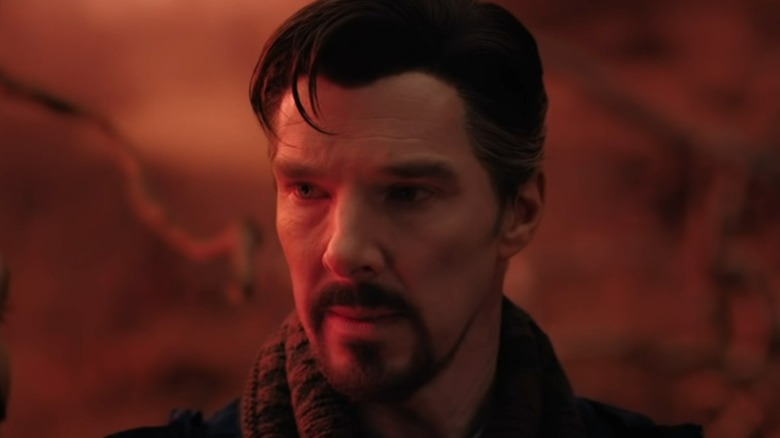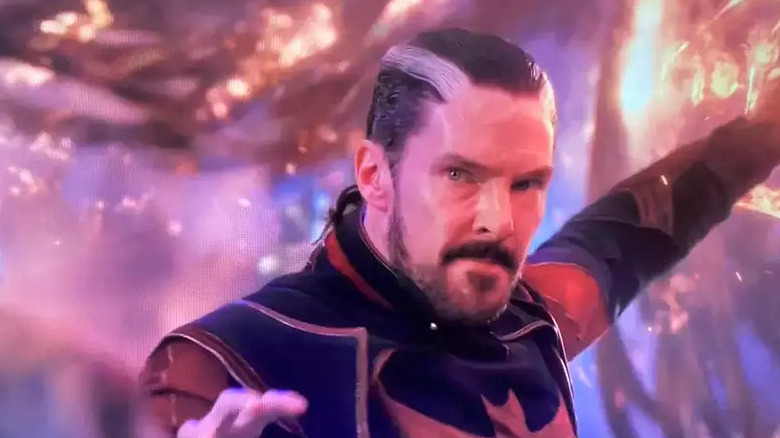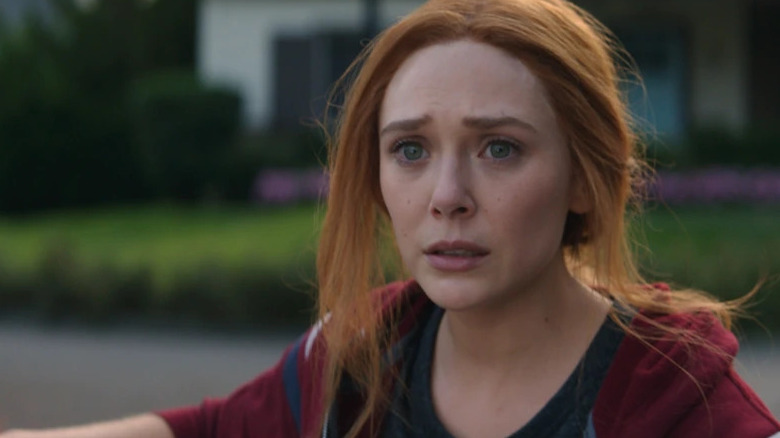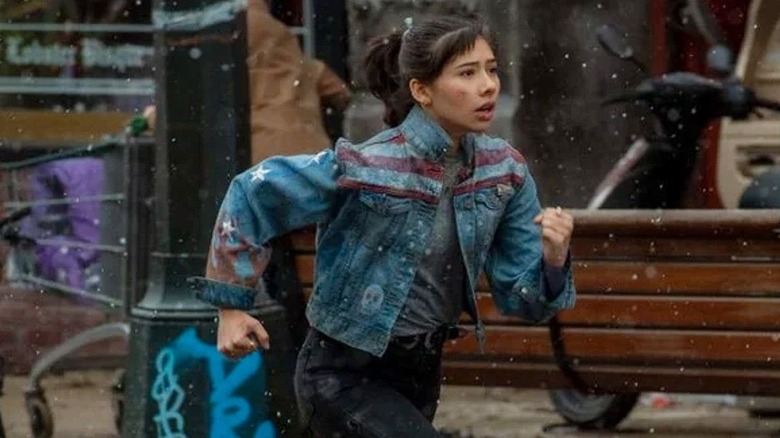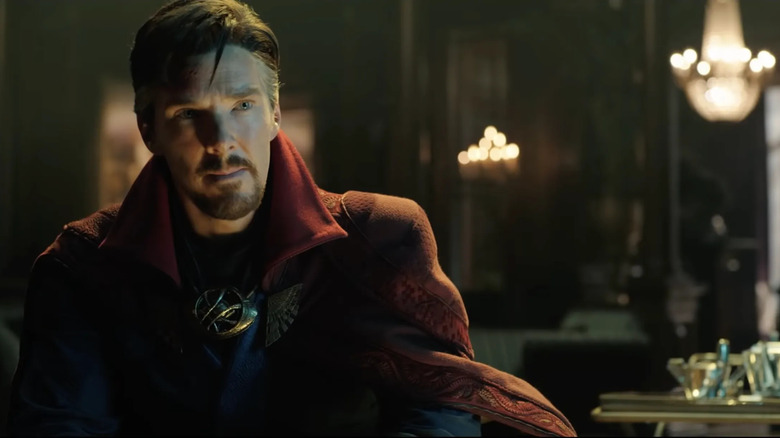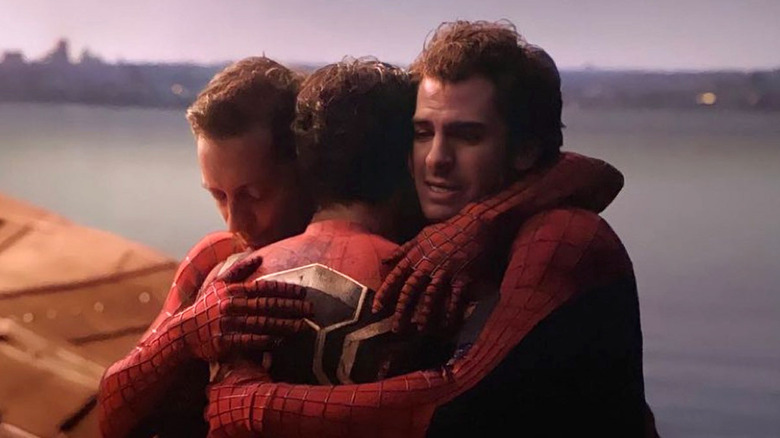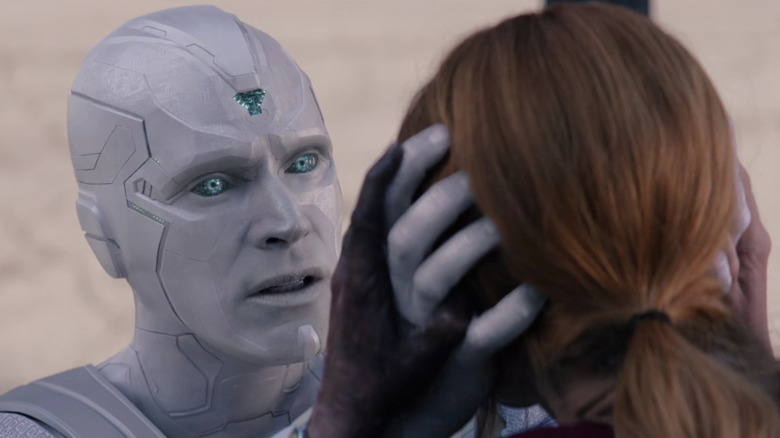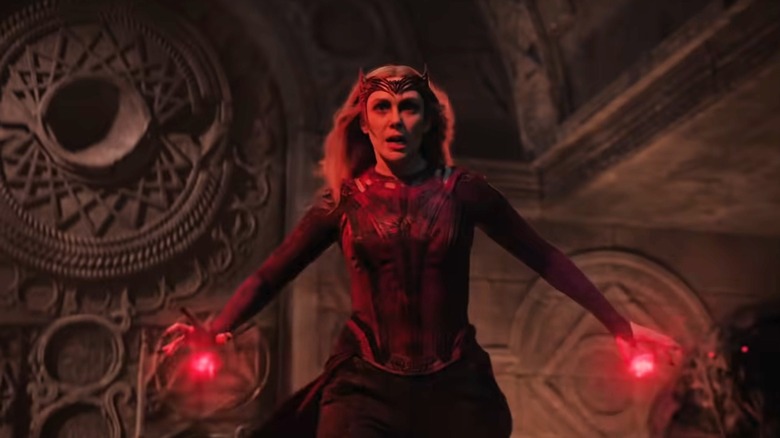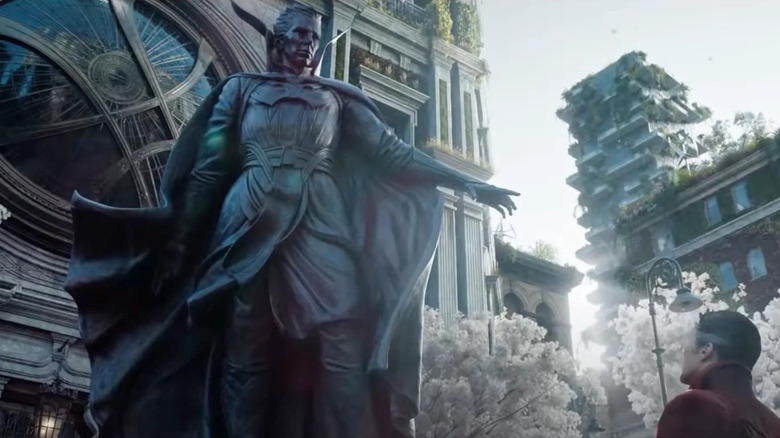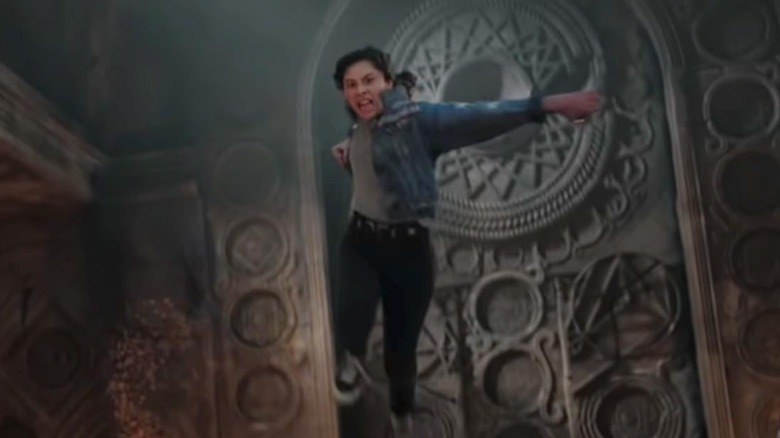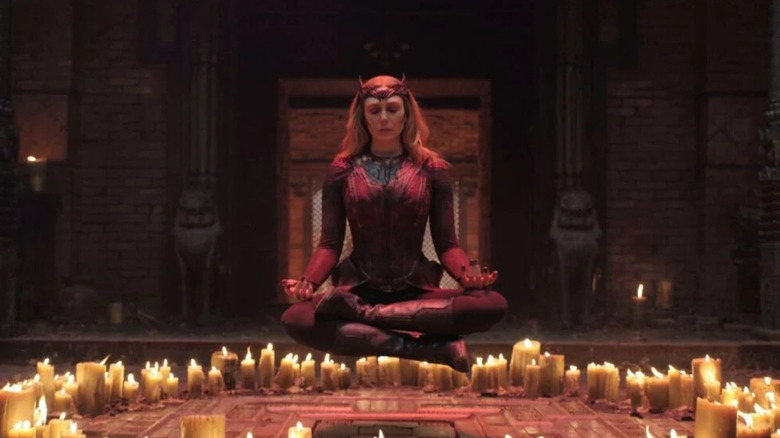The Biggest Plot Holes From Doctor Strange In The Multiverse Of Madness
"Doctor Strange in the Multiverse of Madness" has arrived in theaters, at least in our neck of the multiverse. The 28th film in the Marvel Cinematic Universe successfully combines the over-the-top silly, scary energy of a Sam Raimi movie with the over-the-top budget and scale of an MCU movie, and it boasts two very strong performances. Benedict Cumberbatch is up to the challenge of playing multiple versions of the title character, and Elizabeth Olsen as Wanda Maximoff-turned-the Scarlet Witch is doing some of the franchise's best work to date. In short, the film is a fun, frenetic, and fast-paced trip through semi-accurate comics lore.
But "Doctor Strange in the Multiverse of Madness" isn't everything it had been hyped up to be. Fans expected it to serve as an important Phase Four milestone that brought together important characters and tied up loose ends. Instead, despite the number of cameos, it's really more of a self-contained two hander between Strange and Wanda. To whatever extent it does call back to previous installments, "Multiverse of Madness" creates more plot holes than it resolves. One of those plot holes has to do with the concept of multiverses itself. After viewing this highly anticipated sequel, audiences will likely still be confused as to who broke open the multiverse (was it Wanda? Loki? Kang? Spider-Man? America?) and what happens to it now. These are the problematic plot questions that "Doctor Strange in the Multiverse of Madness" can't quite answer.
Are all dreams windows into the multiverse?
The film opens with a sequence in which an alternate Doctor Strange (Defender Strange) fails to, well, defend America Chavez as she attempts to grab the Book of Vishanti. Our Doctor Strange then wakes up in a cold sweat from what appears to be a bad dream. Very early on in the film, once America invades his reality, Strange comes to understand that his nightmares aren't his guilty subconscious but glimpses into other realities in other universes. Everything he saw in his dream really did happen, which America proves when she drags Defender Strange's corpse out of a rooftop garden shed.
Later on, another Strange variant (Sinister Strange) admits to using the Darkhold to look for universes in which he ended up with Christine. He asks Doctor Strange if he's ever had a dream about falling to his death, then adds that was probably him. The suggestion is he's killed other variants of himself. Throughout the movie, characters suspect that dreams are windows into the multiverse, and it's strongly implied that all dreams function this way.
The idea that dreams could potentially link divergent realities is interesting and has potential, but that potential is completely unexplored in "Doctor Strange in the Multiverse of Madness." No explanation is given, and seemingly contradictory evidence exists in other MCU properties. For example, Wanda manipulates dreams in "Avengers: the Age of Ultron." What characters see has to do with their deepest fears and possible futures in their own reality. One could argue that these were visions and not true dreams, but it strains credibility that every dream — from the banal to the most extreme — in every universe is actually a window into another world.
What happened to Wanda's boys in her own universe?
In the finale of "WandaVision," Wanda comes to terms with what she's done and puts Westview mostly back to how it was. She also traps Agatha Harkness into domestic life as Agnes. Then, she and Vision tuck their kids into bed one last time, knowing that everyone but Wanda will disappear once the Hex wears off. The viewer assumes Vision and the twins, Tommy and Billy, are gone for good. But in an end-credits scene, Wanda's physical form is seeking solace by the lake while her astral form studies the Darkhold. In the very last moment of the series, she hears her boys screaming out for help.
That scene makes it seem as though our Wanda's Tommy and Billy didn't just cease to exist with the Hex, but really are out there somewhere in the multiverse. Many fans assumed the plot of "Doctor Strange in the Multiverse of Madness" would revolve around her traveling from universe to universe searching for their specific variants. Instead, the Scarlet Witch is content to play house in any universe, with any Tommy and Billy. It's curious that, in every reality, the family consists of Wanda and the twins but not Vision, and that all of them remain identical in appearance. Does this mean they're biologically her kids in other universes or is she still operating hexes throughout multiple realities? And what happened to the twins from the Hex if she could still hear them? The boys' status at the end of "WandaVision" is never meaningfully revisited.
Why does America Chavez steal the sling ring?
After Doctor Strange and Wong defeat Gargantos, Strange recognizes America Chavez from his dream the night before and wants to find out who she is. She takes off running, and he realizes she's stolen his sling ring. We can guess that America wants the sling ring because she thinks it might give her enhanced control over her powers and allow her to purposefully travel through portals. But it isn't made explicitly clear that she knows how to use it, and it's not a given that it would work in conjunction with her particular talent for star-shaped multiverse hopping.
This one's less of a plot hole and more of a piece of scrap left over from a rewrite. America Chavez was originally intended to make her first appearance in "Spider-Man: No Way Home," where she and not Ned would've opened portals to allow the Tobey Maguire and Andrew Garfield variants of Peter Parker into Tom Holland's universe. However, because "Doctor Strange in the Multiverse of Madness" was delayed while "Spider-Man: No Way Home" was not, the films premiered in a different order, and both underwent rewrites and reshoots to accommodate the new release schedule. As a result, as entertaining as both movies are, some plot and character arcs feel rushed or incomplete. Ned's instantaneous ability to use the sling ring is one of them. So is this brief moment, which isn't ever contextualized.
How do Strange and Wong remember the Spider-Man spell?
Once Doctor Strange and Wong sit down with America and offer her pizza, she explains who she is (the lone being who can travel between universes) and asks them if they have any experience with the multiverse. Strange answers in the affirmative, and begins to describe the events of "Spider-Man: No Way Home." It is (pardon the pun) strange that Spider-Man's multiversal reverberations don't seem to matter in "Doctor Strange in the Multiverse of Madness," but technically, Strange and Wong shouldn't be able to remember them at all.
The sad resolution to "Spider-Man: No Way Home" is that Peter must simplify the spell, allowing no exceptions, so that even MJ and Ned — and supposedly Doctor Strange and Wong — don't retain any memories about who he really is. A case could be made that Peter One only erased everyone's memories about the fact that he was Spider-Man, and not that Peter Parker or Spider-Man exist at all — after all, J. Jonah Jameson is still ranting about Spidey at the end of "No Way Home." Still, for Strange and Wong to bring up the botched spellcasting incident with America means that they recall the point of it, which was to make everyone forget that Peter One was Spider-Man so that he and his friends had a better chance to get into college after Spidey's reputation took a hit.
If these sorcerer pals are still aware of the events of the previous MCU film, which necessarily involve Peter Parker and his superhero identity, that either suggests the resolution didn't actually work on everyone, or it's just a plot hole Marvel Studios didn't bother to plaster over.
Why do some people look different in other universes?
Another confounding and unexplained aspect of the multiverse: why do some people look almost exactly the same in every reality while others look wildly different? In "Spider-Man: No Way Home," the three variants of Peter Parker are played by the three actors who've portrayed him in live-action on the big screen. Partly, this was a gimmick to narratively link the three franchises and to get Tobey Maguire, Andrew Garfield, and Tom Holland all in the same movie. In another multiverse-minded Marvel property, "Loki," the God of Mischief is depicted as everything from Tom Hiddleston to an alligator. Basically, until now, multiversal variants were more likely than not to vary in appearance.
However, in "Doctor Strange in the Multiverse of Madness," Benedict Cumberbatch, Elizabeth Olsen, Rachel McAdams, and Chiwetel Ejiofor play every variant of Strange, Wanda, Christine, and Mordo. Patrick Stewart shows up as Professor X after having played him in several of Fox's "X-Men" films. Haylee Atwell and Anson Mount reprise their roles as Peggy Carter (in Captain Carter mode) and Black Bolt. Though Maria Rambeau is Captain Marvel on Earth-838, she's still played by the same actor, Lashana Lynch. We don't know yet if John Krasinski will continue to be the MCU's Reed Richards. But basically, in this film, variants are more likely than not to look the same from universe to universe.
Marvel Studios hasn't really explored this subject in any of their movies or TV shows, which makes some of the casting feel like fan service. The explanation surely has more to do with production and contracts than in-universe (or multiverse) canon.
Where are all the Visions?
As "WandaVision" drew to a close, the mystery as to what had become of the real Vision was solved. The Vision who lived with Wanda in the Hex was her creation. The one whose corpse was kept at SWORD headquarters was — after many fruitless attempts — reanimated with traces of Wanda's chaos magic and reprogrammed to destroy Wanda and the projection of Vision. He nearly succeeded until his double stumped him, at which point White Vision essentially downloaded his memories and disappeared.
Many fans anticipated that White Vision would return in "Doctor Strange in the Multiverse of Madness," perhaps to stop Wanda from doing something terrible. Not only is there no White Vision in the film, there's no Vision, period. Wanda and her boys are living in domestic bliss in an infinite number of realities, but Vision doesn't appear to exist in any of them. What happened to all the Visions? How did all those Wandas end up with all those kids?
The lack of Visions is particularly odd in light of the Illuminati's defeat of Thanos in their own universe. It involved the Darkhold and the Book of Vishanti, not (that we know of) Vision's sacrifice. It's possible that Vision never existed on Earth-838, as Ultron bots appear to serve the Illuminati here. But it seems unlikely that Vision would have come to be only on Earth-616, and it seems like an oversight that White Vision doesn't return to deal with Wanda.
Why doesn't Wanda care about Vision anymore?
The whole premise of "WandaVision" is that, following the events of "Avengers: Infinity War," Wanda was so traumatized by the death of her synthezoid soul mate that she mind-controlled an entire town and took on the defensive bureaucracy that she once served, just so she could feign having him back. In "Doctor Strange in the Multiverse of Madness," she is instead single-mindedly focused on getting back to her children — any variants of her children — and she seems to have completely given up hope of ever being with Viz — any Viz — again. This is head-scratch-inducing for a few reasons.
First, Wanda confides in Strange that Vision believed the multiverse was real and had theories about it. Wanda claims she's being "reasonable" as she causes mayhem in the first half of the movie, because of her mother's love. If she knew about the multiverse, especially once she had her hands on the Darkhold, it seems much more reasonable that she'd want to find a reality in which she got to be with her husband and her kids. But, as we've established that there are no Visions to be found out there, even in infinite universes, maybe she knows something that we don't.
Wanda is also aware of the White Vision in her own universe, even though he's gone missing. As overpowered with magic as she's become (even more so once she sees her own likeness carved into the shrine at Mount Wundagore) it defies logic that she wouldn't at least try to bring him under her spell. As good as Elizabeth Olsen's performance is, Wanda's sharp pivot from caring only about Vision to caring only about her kids makes for thin plotting and character development.
Is it Earth-616 or Earth-199999?
When America Chavez and Doctor Strange accidentally travel to another reality, they learn that this one is wise to the multiverse. It's designated itself Earth-838, and it's designated Strange's reality Earth-616. This is a plot complication, both within the Marvel Cinematic Universe and between Marvel Comics and Marvel Studios.
In "Spider-Man: Far From Home," Jake Gyllenhaal's Mysterio tells Peter Parker that he's an interdimensional being and that Peter's universe is called Earth-616. Quentin Beck was, to the best of our knowledge, not from Earth-838; it would be an incredible coincidence for multiple realities to give the MCU's prime Earth the same numeric classification. Some fans have waved away the coincidence by assuming the mention of Earth-616 was nothing but an Easter egg. Still, if the MCU is to be taken as canon down to the last line of dialogue, it's an inconsistency.
There's also an inconsistency between what Marvel Studios calls the MCU's prime reality and what Earth-838 calls it, as well as differences between what happens in the movies versus the comics. Until now, it was widely accepted that Marvel Comics largely took place in a reality known as Earth-616, while the Marvel movies and TV shows took place in one often known as Earth-199999. Though there's an increasing amount of overlap between comics and MCU storylines, the narratives and characters on the page and screen are still very much distinct from each other. While some fans will surely be happy to hear Christine refer to the MCU with the Earth-616 moniker, the Illuminati-like jury is still out on which comics and cinematic universes are which.
How does America Chavez learn to harness her power?
America Chavez is introduced to audiences as a young and reluctant superpower wielder who can't yet control her multiverse-jumping abilities. She also shows the potential for super strength and speed in her fights against Gargantos and Scarlet Witch. To be fair to Xochitl Gomez, comic book and genre film fans have an uneasy history of being harder on young, female characters with fantastical but under-explained skill sets. Rey from "Star Wars" is a classic example. No matter their gender, these types of characters are often used in combination with an older, wiser super who learn their own life lessons as they train their wards. Again, "Star Wars" is chock full of this dynamic, as is the MCU. Both Tony Stark and Doctor Strange had similar relationships with Peter Parker.
But, from Rey to Spidey, at least those characters received some backstory and some on-screen instruction from their mentors, and audiences received some explanation from the script. We have no idea how America got her power — was she born like Thor or forged like Wanda? Then, she's suddenly able to harness her power at will, simply because Doctor Strange believed in her and told her to believe in herself. There's a pretty weak allusion to the concept of controlling one's fear. We see that America first teleported when she was stung by a bee, and every unintentional multiversal trip since has been related to America feeling afraid. Considering the shorter-than-usual runtime of "Multiverse of Madness," the newest MCU character's skill set could've been better illustrated.
Is Wanda a Nexus being?
In contrast to America Chavez, we've spent lots of time watching Wanda become powerful, but we're still somewhat in the dark about just how powerful the Scarlet Witch really is. "WandaVision" and "Loki" both contain Easter eggs and references to Nexus beings, and it's heavily implied that Wanda is one. A "WandaVision" faux commercials contains the tagline, "Nexus: because the world doesn't revolve around you. Or does it?"
The exact definition of a Nexus being is malleable, even in the comics, and is barely even established in the MCU. But generally, these exceedingly rare entities are "keystones to the multiverse" that have the power to manipulate things like time, space, and reality. Their very existence is what keeps the multiverse stable. Some fans have interpreted that Nexus beings necessarily exist in every universe. In other words, if Wanda's a Nexus being, there must be one of her in every reality. However, others believe that Nexus beings exist as single entities with the ability to do whatever they want with reality: i.e. travel between universes. Some fans have surmised that Loki might be a Nexus being, which is how he's able to operate within different dimensions in his own TV show, even when he encounters other Lokis.
If the latter is true, Wanda should've been able to leap from multiverse to multiverse already, or she should've been able to manipulate them without having to dream-walk. It's a little too convenient that, despite the fact that she's a nearly all-powerful being with access to a nearly all-powerful spell book, she needs the specific gift of a single, inexperienced child (whom she must kill) to accomplish her ultimate goal.
